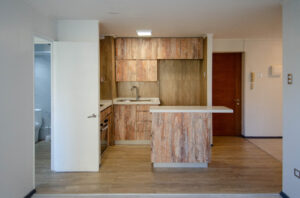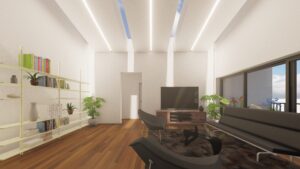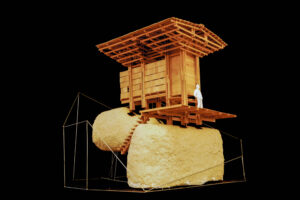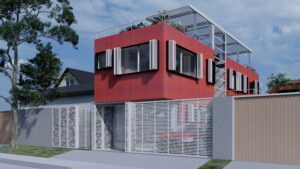
Villa Portales Kindergarten
The project takes on the task of designing a children’s kindergarten and Nursery for children aged 1 to 4, harnessing the social value of the program and its capacity to transform the use of the surrounding public space. The project is situated within the collective housing complex Villa Portales, designed by modern architects Bresciani, Valdés, Castillo, and Huidobro in 1966. Due to its size and location, the complex located in the Estación Central commune in Santiago, Chile, is an architectural landmark for the city center and boasts high residential density within a mixed-use environment.
Despite this, a significant portion of the complex’s public space is deteriorated and abandoned, primarily due to the lack of defined complementary uses. Our hypothesis is that by introducing a program like this into one of the vacant spaces within the complex, the environment can be improved by activating public space, meeting a population need, and strengthening the necessary social networks for place appropriation and identity, replacing an unsafe space prone to criminal activity with a controlled one. The project involves creating an excavated courtyard that forms a recreational space, which, while connected to the context, operates independently without the need for a fence to separate public and private spaces.
Structurally, the building consists of a series of frames arranged around a center, forming a radial shape according to the play areas it covers. The building is supported on the ground through direct foundations, except for a section that extends over the sunken square, resting on the terrain at its ends and forming a curved bridge over the mentioned sunken area. The frames are reinforced on the outer perimeter ring due to the flexion of the structure. The edge beam has the full height of the building, providing adequate stiffness to support the upper roof beams and lower floor beams. The outer perimeter beam is formed by an upper chord at the roof height, a lower chord at floor height, and vertical and diagonal members that connect the chords. This way, a highly rigid piece is created, capable of supporting the weight transferred by the upper and lower beams in the cantilevered area.
The roof consists of a PVC membrane, which was chosen for its lightweight properties, ability to allow natural light to enter from the outside, and promotion of cross-ventilation. The structure is very rigid, capable of transmitting most of the horizontal wind and seismic forces to the exterior frame and to a lesser extent to the elliptical interior frame with support columns. The building’s structural design can only be efficiently realized with steel structures due to the presence of high trusses, long beams, rigid frames, and the need for low weight. Inside the volume, spaces are organized by grouping related programs. The resulting space is proposed as circulation and areas for expanding activities. By avoiding corners, this understanding of the boundary allows for better control of children inside the garden.
The open central courtyard maintains a perimeter path where the exterior spaces of the building hang. The excavation of the courtyard is contained by shoring with steel plates, providing formal freedom and continuity without compromising the structure. Using the excavated soil, an artificial topography is created that generates a variety of play spaces. The intersection between the excavated courtyard or how to achieve control without a fence and the steel structure that protects another space generates the architectural potential of the problem. The elliptical structure due to how its continuity works, generating two rigid rings that function entirely due to their non-deformable nature. Connected through rigid frames that support the spaces.
The interior distribution of spaces based on arches, maintaining the curved shape and the importance of security due to the panopticon that is generated, which allows the entire space to be visible from the center.






